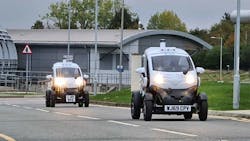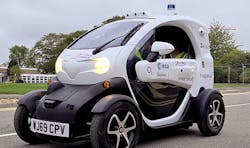The Darwin SatCom Lab has become the UK’s first commercial laboratory to test driverless cars. Based at the Harwell Science and Innovation Campus in Oxfordshire, which is also home to the European Space Agency’s (ESA) Centre for Space Applications and Telecommunications, it will allow companies to put self-driving car theories into practice and test their ideas using connected and autonomous vehicles (CAVs).
Employing both 5G and satellite communications, companies can test proofs of concept using two Renault TWIZY two-seat electric cars. Telecom company O2 converted them into CAVs, fitting them with LiDAR sensors so that they can be controlled from the lab and driven around the Harwell Campus.
The laboratory for 5G and satellite communications is part of Project Darwin, supported by the ESA and O2. The four-year trial program is aimed at developing next-generation connectivity technology for CAVs.
By providing faster and more reliable data signals, 5G addresses many of the technical challenges faced by self-driving cars. In particular, 5G can minimize the time it takes for information to be sent and received, trimming latency, which is vital to the development of these cars.
Compared to 4G, 5G could slash the current 20 ms of lag to 1 ms or less. This low latency and the high capacity provided by 5G technology (5G has a data rate of 20 Gb/s while 4G mobile phones operate with a throughput of about 1 Gb/s) enables vehicles to transmit vast amounts of data—including 4K video—to cloud-based systems.
Industry estimates say as much as 4 TB per hour will be sent, resulting in enhanced road safety and more precise monitoring and handling of traffic flow.
Using 5G equipment provided by Nokia and geosynchronous communications satellites (GEOs) from Spanish satellite operator Hispasat, O2’s 5G team can remotely track the status of the TWIZY CAVs, including their position, movement, and speed. A digital-twin version will be broadcast to screens in O2’s laboratory at the University of Glasgow and at the company’s headquarters in Slough, England.
“The strength of the Lab,” said Rodrigo Barreto, Head of Enterprise Architecture at the Darwin Innovation Group, “lies in combining 5G and satellite communications, opening up the possibility of creating mobility services that can fall back on satellite communications in scenarios where 5G is not always available.”
Commented UK Science Minister Amanda Solloway, “O2’s first-of-its-kind driverless car lab will enable our most innovative businesses to test these technologies and bring us another step closer to putting self-driving vehicles safely on our roads.”
A new communications infrastructure using satellites in low Earth orbit (LEO) will soon provide access to broadband connectivity to those communities, businesses, and governments outside of 5G networks. This will ensure that self-driving vehicles remain connected in remote and harder-to-reach areas.
OneWeb is the communications company building a LEO satellite constellation intended to provide these broadband satellite links. On October 2, the United States Bankruptcy Court for the Southern District of New York confirmed OneWeb’s Chapter 11 plan of reorganization, enabling the company to deploy the initial 650-LEO-satellite constellation under the new ownership of the UK Government and Bharti Global Limited.
Arianespace launches for OneWeb are scheduled to resume in December 2020; OneWeb’s return-to-flight launch will increase its in-orbit fleet to 110 satellites. Commercial services is planned to start next year. Initial regions will include the United Kingdom, Alaska, Northern Europe, Greenland, Iceland, the Arctic seas, and Canada.
One of the proofs of concept already being tested at the Darwin SatCom Lab tracks the CO2 emissions of vehicles by using the CAV’s LiDAR sensors. Satellite images are employed to see the areas that vehicles are traveling through and monitor local biodiversity. From this data, O2’s 5G Innovation team can calculate the emissions savings of taking different routes based on carbon capture from nearby trees.

